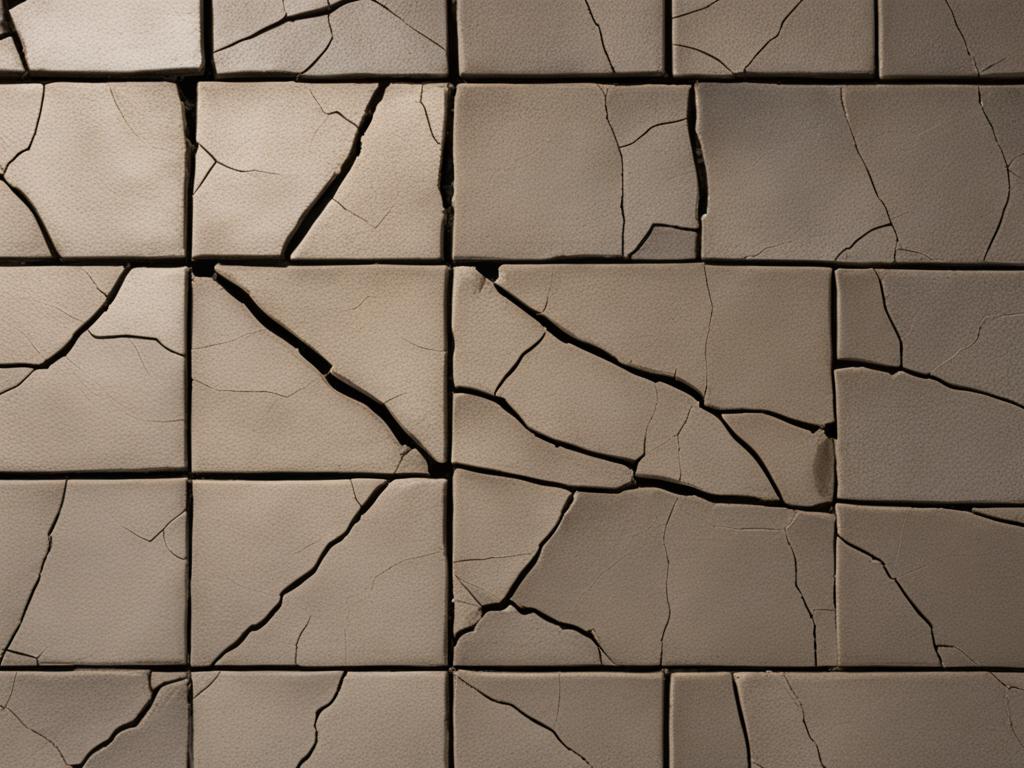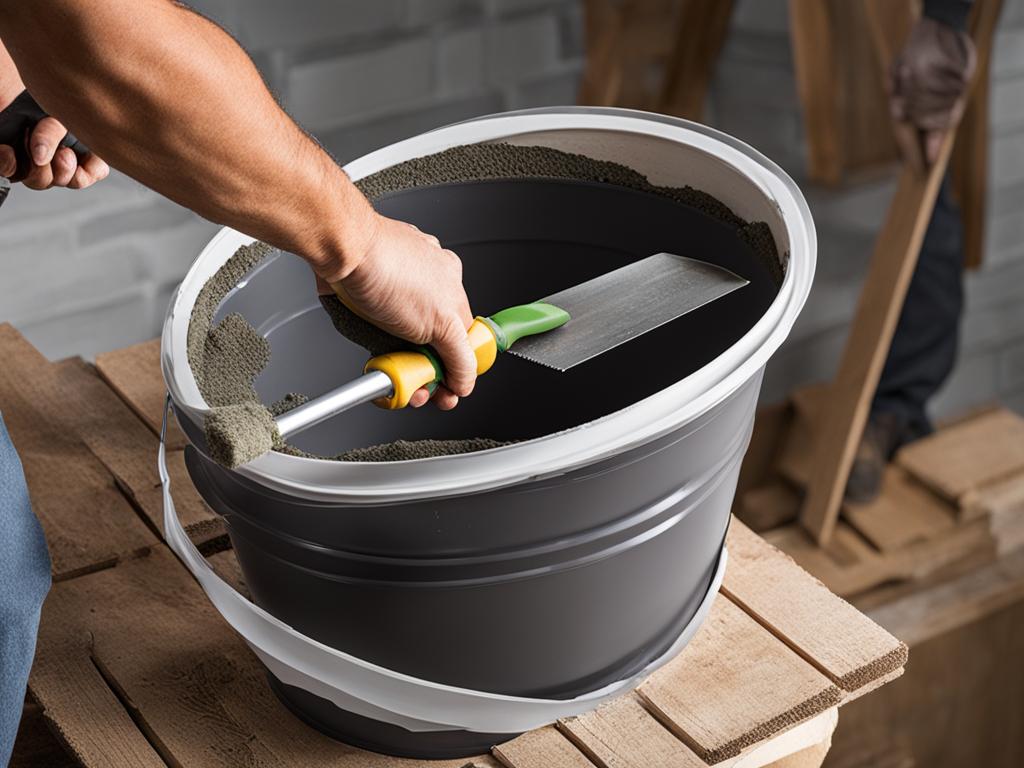Premixed thinset and mix-it-yourself thinset are two options to consider when choosing a tile adhesive for your tile installation and home renovation projects. The decision between the two depends on various factors such as quality, ease of use, cost, and suitability for different applications. Let’s explore the pros and cons of each option to help you make an informed choice.
Key Takeaways:
- Premixed thinset offers convenience but may not provide the same level of strength and durability as mix-it-yourself thinset.
- Mix-it-yourself thinset allows for greater control and ensures a strong bond, making it suitable for various applications.
- Consider the specific requirements of your tile installation project when choosing between the two options.
- Both premixed and mix-it-yourself thinset have their advantages and can be used for DIY projects and home renovations.
- The best thinset for your project will depend on factors such as project scope, tile size, and desired durability.
Pros and Cons of Premixed Thinset
Premixed thinset is a popular choice for tile installation due to its convenience and time-saving properties. With ready-to-use adhesive straight from the package, there’s no need to spend extra time and effort in mixing the thinset. This is particularly beneficial for DIY enthusiasts or homeowners looking to complete their projects quickly. Premixed thinset offers a tight bond, ensuring that your tiles stay securely in place.
One of the advantages of premixed thinset is its ability to resist moisture, making it ideal for areas prone to water exposure such as shower pans, bathroom floors, and kitchen countertops. The moisture-resistant properties help prevent mold and mildew growth, providing a durable and hygienic surface for your tiling projects.
Disadvantages of Premixed Thinset
Despite its convenience, premixed thinset has its drawbacks. One of the main disadvantages is the possibility of cracking. Premixed thinset may not be as flexible as its mix-it-yourself counterpart, making it more prone to cracking under certain conditions. Additionally, achieving full strength may require the use of additives, which can add extra cost and complexity to your project.
Another limitation of premixed thinset is its suitability for specific applications. It is not recommended for wet areas where constant exposure to water is expected, such as swimming pools or water features. Additionally, premixed thinset may not be suitable for larger tiles, typically larger than 6×6 inches, as the adhesive strength may not be sufficient to support their weight.
Best Thinset for Tile Installation
While premixed thinset offers convenience, it may not be the best option for all tile installation projects. For optimal results, it’s essential to consider the specific requirements and challenges of your project. Depending on factors such as tile size, application area, and desired durability, mix-it-yourself thinset may prove to be a better choice.
By mixing the thinset yourself, you have greater control over its consistency, ensuring proper installation and a stronger bond. Powdered thinset cures through a chemical reaction rather than evaporation, resulting in a more durable adhesive. It is also more versatile and suitable for various applications, including wet areas and larger tiles. While mix-it-yourself thinset requires more effort in terms of mixing, the added control and durability make it a preferred option for professionals and experienced DIY enthusiasts alike.

| Advantages of Premixed Thinset | Disadvantages of Premixed Thinset |
|---|---|
| Convenient and ready-to-use | Possibility of cracking |
| Tight bond and moisture resistance | Additives may be required for full strength |
| Time-saving for quick projects | Not recommended for wet areas |
| Not suitable for larger tiles |
Advantages of Mix-It-Yourself Thinset
Mix-it-yourself thinset, also known as powdered thinset mortar, offers several advantages over premixed thinset. Let’s take a closer look at the benefits of using mix-it-yourself thinset for your DIY projects.
Greater Control and Proper Installation
One of the key advantages of mix-it-yourself thinset is the ability to have greater control over the consistency of the mortar. By mixing it yourself, you can ensure that the thinset is properly mixed to achieve the right texture and workability for your specific tile installation.

Stronger Bond and Durability
Another advantage of mix-it-yourself thinset is that it cures through a chemical reaction, rather than relying on evaporation like premixed thinset. This chemical reaction results in a stronger bond between the tiles and the substrate, providing increased durability and longevity.
User-Friendly and Minimizes Waste
Despite the need for mixing, mix-it-yourself thinset is considered user-friendly. With clear instructions provided by the manufacturer, even DIY enthusiasts can easily mix the thinset to the desired consistency. Additionally, mix-it-yourself thinset can be mixed in smaller batches, which helps minimize waste and ensures that you only mix the amount needed for your project.
Suitable for Various Applications
Mix-it-yourself thinset is versatile and suitable for a wide range of tile installation applications. Whether you’re working on shower pans, bathroom walls, kitchen floors, or living area walls, mix-it-yourself thinset provides a reliable adhesive that can withstand the demands of different environments.
Overall, while mix-it-yourself thinset requires more effort to mix compared to premixed thinset, its advantages in terms of control, bond strength, user-friendliness, and versatility make it an excellent choice for your DIY projects and tile installations.
Conclusion
When it comes to tile installation and home renovations, choosing the right thinset option is crucial for a successful project. Two popular choices are premixed thinset and mix-it-yourself thinset. While premixed thinset offers convenience with its ready-to-use formula, it may not provide the same level of strength and durability as mix-it-yourself thinset.
Mix-it-yourself thinset, on the other hand, allows for greater control over the consistency and ensures a strong bond. It is suitable for various applications, including shower pans, bathroom walls, kitchen floors, and living area walls. The ability to mix smaller batches also minimizes waste, making it a cost-effective option.
Ultimately, the best thinset for your tile installation and home renovation needs will depend on factors such as project scope, tile size, and desired durability. Consider the specific requirements of your project and choose the thinset option that will provide the best results for your specific application. Whether you opt for the convenience of premixed thinset or the flexibility of mix-it-yourself thinset, a well-chosen adhesive will ensure a long-lasting and visually stunning tile installation.
FAQ
What is the difference between premixed thinset and mix-it-yourself thinset?
Premixed thinset is adhesive that comes ready-to-use straight from the package, while mix-it-yourself thinset is a powdered mortar that requires mixing with water.
Is premixed thinset suitable for wet areas?
Premixed thinset is not recommended for wet areas or tiles larger than 6×6 inches.
Can premixed thinset crack?
Yes, premixed thinset may crack and require additives to achieve full strength.
What are the advantages of mix-it-yourself thinset?
Mix-it-yourself thinset allows for greater control over consistency, provides a stronger bond, and is suitable for various applications.
Which thinset is best for tile installation projects?
The best thinset for your tile installation project will depend on factors such as scope, tile size, and desired durability.
Can mix-it-yourself thinset be mixed in smaller batches?
Yes, mix-it-yourself thinset can be mixed in smaller batches to minimize waste.
Is premixed thinset easy to work with?
Yes, premixed thinset is easy to work with, but it may not be the best option for all tile installation projects.
Source Links
- https://www.johnbridge.com/vbulletin/archive/index.php/t-40496.html
- https://www.diychatroom.com/threads/pros-and-cons-of-ready-mixed-mortar-vs-the-powder-you-mix-for-tile-flooring.645749/
- https://www.thespruce.com/tile-mortar-guide-thinset-mastic-and-epoxy-1821651
